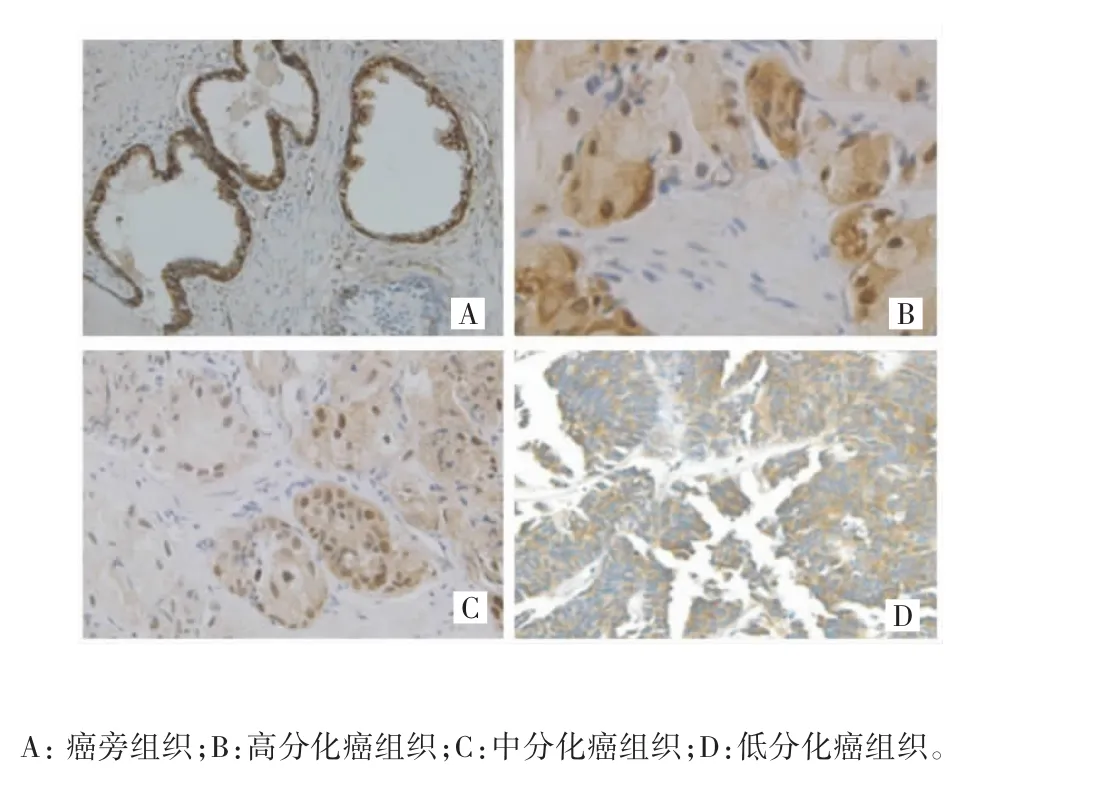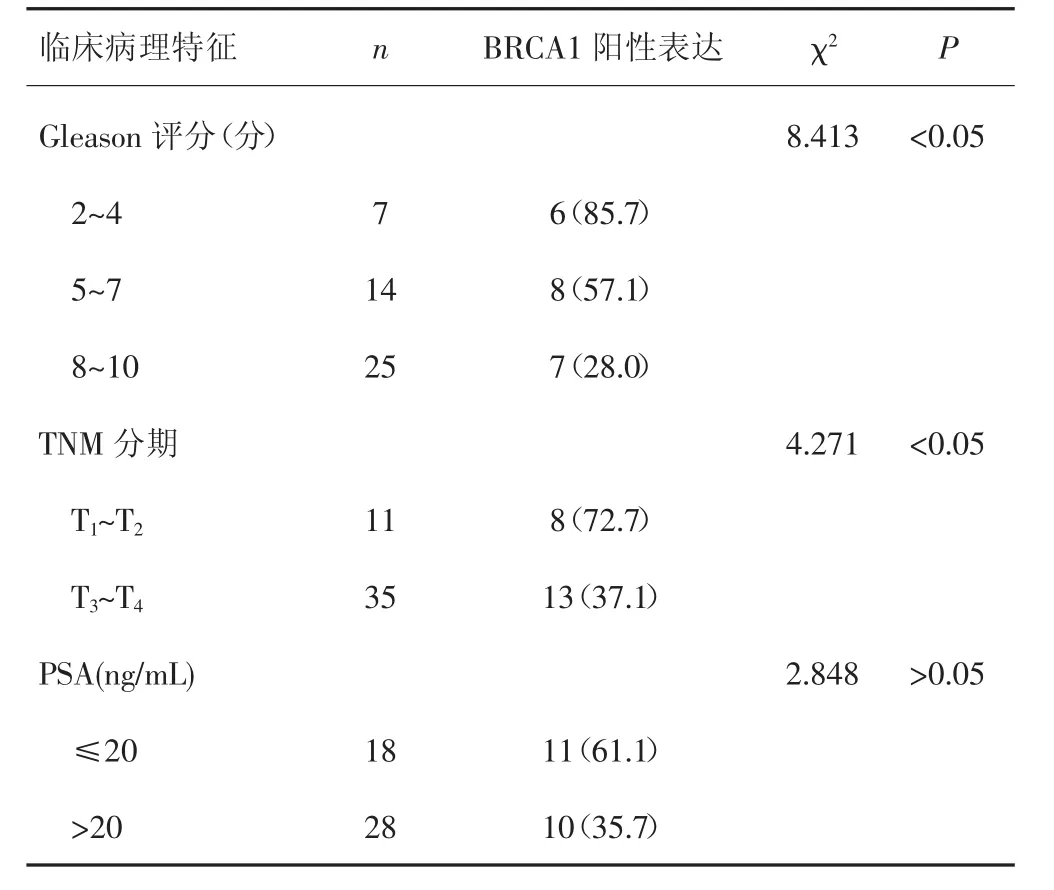BRCA1在前列腺癌组织中的表达及临床意义
相娜娜张克克
临床研究
BRCA1在前列腺癌组织中的表达及临床意义
相娜娜1张克克2
目的 探讨乳腺癌易感基因1(breast cancer susceptibility gene-1,BRCA1)在前列腺癌组织中的表达及临床意义。方法 采用SP免疫组化法检测46例前列腺癌组织及14例癌旁组织中BRCA1的表达,分析BRCA1表达与前列腺癌临床病理特征的关系。结果14例前列腺癌旁组织中BRCA1阳性表达率为78.6%(11/14),46例前列腺癌组织中BRCA1阳性表达率为45.7%(21/46),两者比较差异有统计学意义(P<0.05)。BRCA1表达与前列腺癌家族史、Gleason评分和TMN分期有关(P<0.05),与年龄和前列腺特异性抗原(prostate specific antigen,PSA)浓度无关(P>0.05)。结论 BRCA1在前列腺癌组织中低表达,且随肿瘤恶性程度增加其表达降低,提示检测BRCA1蛋白对前列腺癌辅助诊断及预后判断有一定参考价值。
前列腺肿瘤;乳腺癌易感基因1;免疫组织化学;临床意义
前列腺癌(prostate cancer,PCa)是男性泌尿生殖系统最常见的恶性肿瘤之一,其发病率逐年升高[1,2]。目前前列腺癌早期诊断主要依靠检测血清中前列腺特异性抗原(prostate specific antigen,PSA)[3]。当PSA检测结果在4~10 ng/mL,即所谓“灰区”时,常常不易确诊。因此,亟需寻找灵敏度更高及特异性更强的标志物。
乳腺癌易感基因1(breast cancer susceptibility gene-1,BRCA1)是一种抑癌基因。其定位于人染色体17q21,编码含1 863个氨基酸的蛋白质,由N端、C端和中间ATM、ATR的磷酸化区三部分组成,分子量为220kDa,是一种DNA结合蛋白[4,5]。BRCA1基因与其他肿瘤抑制因子和信号通路分子组成复合体,在DNA损伤修复及重组、转录、活化、抑制及细胞周期调节等生物学过程中发挥重要作用,但在肿瘤抑制方面的作用机制尚不完全清楚[6]。有研究指出BRCA1发生突变的男性更易患侵袭性强的前列腺癌[7]。但目前有关BRCA1与前列腺癌的研究较少,为探究BRCA1在前列腺癌临床诊断及预后判断中的价值,本研究采用SP免疫组化法检测BRCA1在前列腺癌组织中的表达,探讨其表达与前列腺癌临床病理特征的关系,现将结果报道如下。
1 资料与方法
1.1 临床资料
标本来自洛阳市中心医院2013年8月至2015年7月手术切除的前列腺癌组织和癌旁组织。其中癌组织标本46例,癌旁组织标本14例。年龄39~75岁,平均年龄64.27岁。按临床TNM分期:T1~T2期11例,T3~T4期35例;按Gleason评分标准:低分化癌(8~10分)25例,中分化癌(5~7分)14例,高分化癌(2~4分)7例。所有标本均经福尔马林固定,石蜡包埋后行4μm连续切片。14例癌旁组织作为阳性对照,以PBS液代替一抗作为阴性对照。
1.2 检测方法
应用SP免疫组化法,实验步骤按试剂盒说明书进行。BRCA1抗体(兔抗人多克隆抗体)购自SIGMA公司,抗兔二抗购自北京西美杰科技有限公司,SP 9000免疫组化试剂盒购自上海研卉生物科技有限公司。
1.3 结果判定
由两位病理科主治医师采用双盲法读片,光镜下观察整个切片,每例切片随机选择5个高倍镜视野进行判定,每个视野计数100个细胞,每例标本计数3张切片。免疫组化阳性染色为细胞核和(或)细胞质内出现明显棕黄色或棕褐色颗粒。参照二级计分法:⑴阳性细胞百分率≤5%计0分,6%~25%计1分,26%~50%计2分,51%~75%计3分,>75%为4分;⑵细胞染色强度无染色计0分,弱染色(浅黄色)计1分,中等染色(棕黄色)计2分,强染色(棕褐色)计3分。两项得分相乘:0分设为阴性(-),1~4分为弱阳性(+),5~8分为中等阳性(++),9~12分为强阳性(+++);设≤4分为低表达,>4分为高表达。
1.4 统计学方法
采用SPSS 18.0软件对数据进行统计处理,样本率的比较采用χ2检验或四格表确切概率法。以P<0.05表示差异有统计学意义。
2 结果
2.1 BRCA1在前列腺癌组织和癌旁组织中的表达
BRCA1阳性染色呈棕黄色颗粒,主要位于细胞质与细胞核。在14例前列腺癌旁组织中BRCA1阳性表达率为78.6%(11/14);46例前列腺癌组织中BRCA1阳性表达率为45.7%(21/46),两者比较差异有统计学意义(P<0.05)。见图1。

图1 BRCA1在前列腺癌组织和癌旁组织中的表达(SP法,×200)
2.2 前列腺癌中BRCA1表达与临床病理特征的关系
BRCA1阳性表达与前列腺癌家族史、Gleason评分及TNM分期相关(P<0.05),而与年龄和PSA浓度无相关性(P>0.05)。见表1。

表1 前列腺癌中BRCA1表达与临床病理特征的关系[n(%)]

(续表)
3 讨论
BRCA1基因是1990年发现的直接与遗传性乳腺癌有关的基因。BRCA1不仅是肿瘤抑制因子,还在有丝分裂细胞周期调控、DNA损伤修复、组蛋白乙酰化以及转录激活等生物学过程中发挥重要作用[8]。Rb、p16、p21、BRCA和PTEN等均是调控细胞周期的乳腺癌抑癌基因[9],BRCA1基因发生突变的家族更倾向于具有高乳腺癌发生率。研究指出BRCA1基因突变者患癌症终身风险为50%~85%,患乳腺癌及卵巢癌风险为15%~45%[7]。而BRCA1基因主要发生以下两方面异常,一是肿瘤抑制基因(肿瘤生长负调节因子)突变;二是BRCA1表达缺失,这两种异常均可能导致细胞正常功能失控及恶性进展。BRCA1基因与雌激素关系密切,而前列腺癌作为与乳腺癌类似的激素依赖性癌症,BRCA1基因在前列腺癌中的作用也引起了广泛关注。Leongamornlert等[7]研究表明,0.45%的前列腺癌患者BRCA1基因发生胚系突变,其患癌风险增加了3.5倍,同时更易进展为恶性程度更高的前列腺癌,预后更差,说明BRCA1基因突变可能是前列腺癌发生的一个重要影响因素。有研究报道,在散发型乳腺癌和卵巢癌中均发现BRCA1蛋白表达明显降低,提示其与散发型乳腺癌和卵巢癌高度相关[6,10,11];在胰腺癌中亦有类似报道[12]。本研究采用免疫组化技术检测46例前列腺癌组织及其14例癌旁组织中BRCA1的表达,结果发现,前列腺癌组织中BRCA1阳性表达率为45.7%,明显低于癌旁组织的78.6%,表明BRCA1可能参与了前列腺癌发生、发展过程,而有效调控BRCA1表达可能有助于前列腺癌的预防及治疗。
BRCA1蛋白位于细胞核,为核内磷酸化蛋白。最近研究指出BRCA1蛋白是一种细胞核和细胞质互动蛋白。乳腺癌、卵巢癌及胰腺癌细胞照射后均出现BRCA1蛋白出核现象[13]。但是具体的出核机制目前尚不清楚,有可能与p53蛋白的功能相关或受其上游调节[14]。本研究在前列腺癌组织细胞质和细胞核中均发现该蛋白存在,可能正是由尚不明确的核质互动机制引起。
目前血清PSA被认为是前列腺癌较敏感的生物学标志物,被广泛应用于检测前列腺癌发生、进展及复发。Bantis等[15]报道,当PSA含量超过20 ng/mL且Gleason评分在8分以上时,前列腺癌发生骨转移概率增加。本研究分析前列腺癌中BRCA1表达与其临床病理特征的关系,但未发现BRCA1表达与患者年龄及PSA浓度相关,可能与本研究阳性样本量较少有关,二者关系有待进一步研究。Gleason评分是前列腺癌诊断和预后判断的一个重要指标。研究表明,Gleason评分越高,患者预后越差,死亡率亦越高[16]。本研究结果显示,BRCA1在前列腺癌组织中低表达,且随Gleason评分与TNM分期增高其表达逐渐降低,认为BRCA1低表达与前列腺癌发生、进展有关,检测BRCA1蛋白对前列腺癌辅助诊断及预后判断有一定参考价值。
[1] S iege l R,M a J,Z ou Z,e t a l.C an c e r s t a t i s t i c s,2014[J].CA C an c e r J C l in,2014,64(1):9-29.
[2] 陈鹏军.我国人口老龄化趋势、影响及对策研究[J].重庆工商大学学报(社会科学版),2011,28(3):61-64.
[3] P a s hayan N,P ha r oah P,N ea l D E,e t a l.S t age s hi ft in P S A-d e t e ct e d p r o s t a t e c an c e r s-e ff e ct mo d i f i c a t ion b y G l ea s on s c o r e[J].J M e d S cr een,2009,16(2):98-101.
[4] S a l ga d o J,Z a b a l egui N,G a rcía-A migo t F,e t a l.S tr u ct u r e-b a s e d a ss e ss men t o f BRCA1 an d BRCA2 mu t a t ion s in a s ma ll S pani s h popu l a t ion[J].O n c o l R ep,2005,14(1):85-88.
[5] B an cr o ft E K,E e l e s RA.C o rr igen d um t o“t a r ge t e d p r o s t a t e c an c e r s cr eening in BRCA1 an d BRCA2 mu t a t ion c a rr ie r s:r e s u lt s fr om t he ini t ia l s cr eening r oun d o f t he I MPAC T s t u d y”[J].E u r U r o l,2015,67(6):e126.
[6] G a r g K,L e v ine D A,O l v e r a N,e t a l.BRCA1 immunohi s t o c hemi s tr y in a mo l e c u l a rl y c ha r a ct e r i z e d c oho rt o f o v a r ian high-g r a d e s e r ou s c a rc inoma s[J].A m J S u r g P a t ho l,2013,37(1):138-146.
[7] L eongamo r n l e rt D,M ahmu d N,T ym r a k ie w i c z M,e t a l.G e r m l ine BRCA1 mu t a t ion s in cr ea s e p r o s t a t e c an c e r r i s k[J].B r J C an c e r,2012,106(10):1697-1701.
[8] F r ie d en s on B.T he BRCA1/2 pa t h w ay p r e v en t s hema t o l ogi c c an c e r s in a dd i t ion t o br ea s t an d o v a r ian c an c e r s[J].BMC c an c e r,2007,7(1):152.
[9] K o t s opou l o s J,L u b in s k i J,G r on w a ld J,e t a l.F a ct o r s in fl uen c ing o v u l a t ion an d t he r i s k o f o v a r ian c an c e r in BRCA1 an d BRCA2 mu t a t ion c a rr ie r s[J].I n t J C an c e r,2015,137(5):1136-1146.
[10] Z hong Q,P eng H L,Z hao X,e t a l.E ff e ct s o f BRCA1-an d BRCA2-r e l a t e d mu t a t ion s on o v a r ian an d br ea s t c an c e r s u r v i v a l:a me t a ana l y s i s[J].C l in C an c e r R e s,2015,21(1):211-220.
[11] P huah S Y,L ooi LM,H a ss an N,e t a l.Tr ip l e-nega t i v e br ea s t c an c e r an d P T E N(pho s pha t a s e an d t en s in homo l ogue)l o ss a r e p r e d i ct o r s o f BRCA1 ge r m l inemu t a t ion s in w omen w i t h ea rl y-on s e t an d f ami lia l br ea s t c an c e r,b u t no t in w omen w i t h i s o l a t e d l a t e-on s e t br ea s t c an c e r[J].B r ea s t C an c e r R e s,2012,14(6):R142.
[12]L yn c h H T,De t e r s CA,S ny d e r CL,e t a l.BRCA1 an d pan cr ea t i c c anc e r:pe d ig r ee f in d ing s an d t hei r c au s a l r e l a t ion s hip s[J].C an c e r G ene t C y t ogene t,2005,158(2):119-125.
[13] W iene r D,G aja rd o-M ene s e s P,O rt ega-H e r nán d e z V,e t a l.BRCA1 an d BAR D1 c o l o c a l i z emain l y in t he c y t op l a s m o f br ea s t c an c e r t umo r s,an d t hei r i s o f o r m s s ho w d i ff e r en t ia l e x p r e ss ion[J].B r ea s t C anc e r R e s Tr ea t,2015,153(3):669-678.
[14]V an d e W ou w e r M,C ou z iniéC,S e rr ano-P a l e r o M,e t a l.A ct i v a t ion o f t he BRCA1/C h k1/p53/p21(C ip1/W a f1)pa t h w ay b y ni tr i c o x i d e an d c e ll c y cl e a rr e s t in human neu r o bl a s t oma N B69 c e ll s[J].N i tr i c O xi d e,2012,26(3):182-191.
[15]B an t i s A,G r amma t i c o s P.P r o s t a t i c s pe c i f i c an t igen an d b one s c an in t he d iagno s i s an d f o ll o w-up o f p r o s t a t e c an c e r.C an d iagno s t i c s igni f ic an c e o f P S A b e in cr ea s e d?[J].H e ll J N u cl M e d,2011,15(3):241-246.
[16] M i t ha l P,H o w a rd LE,A r on s on W J,e t a l.P r o s t a t e-s pe c i f i c an t igen l e v e l,s t age o r G l ea s on s c o r e:W hi c h i s b e s t f o r p r e d i ct ing ou tc ome s a ft e r r a d i c a l p r o s t a t e ct omy,an d d oe s i t v a r y b y t he ou tc ome b eing mea s u r e d?R e s u lt s fr om S ha r e d E q ua l A cc e ss R egiona l C an c e r H o spi t a l d a t a b a s e[J].I n t J U r o l,2015,22(4):362-366.
[2016-06-03收稿][2016-07-18修回][编辑 江德吉]
BRCA1 expression in prostate carcinoma and its clinical significance
Xiang Nana1,Zhang Keke2(1Department of Oncology,Luoyang Central Hospital Affiliated to Zhengzhou University,Luoyang 471000,P.R.China;2Department of Urology,Xijing Hospital,the Fourth Military Medical University,Xi′an 710032,P.R.China)
Objective To analyze breast cancer susceptibility gene-1(BRCA1)expression and its clinical significance in prostate carcinoma.M ethods BRCA1 expression was analyzed using immunohistochemistry in 46 prostate carcinoma tissue sections and 14 adjacent normal tissue sections.Possible relationships were explored between BRCA1 expression and clinicopathological variables. Results Rate of BRCA1 positivity was 78.6%for adjacent normal tissue,but only 45.7%for prostate carcinoma.BRCA1 expression levels were significantly lower in prostate carcinoma tissues than in adjacent normal tissues(P<0.05).BRCA1 expression level correlated with family history,Gleason classification and TMN stage(P<0.05),but not with age or prostate-specific antigen(PSA)(P>0.05).Conclusion Prostate carcinoma is associated with lower BRCA1 expression,and lower expression may correlate with greater tumormalignancy.BRCA1may be a useful diagnostic and prognostic biomarker in prostate cancer.
Prostatic neoplasm;Breast cancer susceptibility gene-1;Immunohistochemistry;Clinical significance
471000 洛阳1郑州大学附属洛阳中心医院肿瘤科;710032 西安2第四军医大学西京医院泌尿外科
R737.25
A
1674-5671(2016)04-04
10.3969/j.issn.1674-5671.2016.04.04

